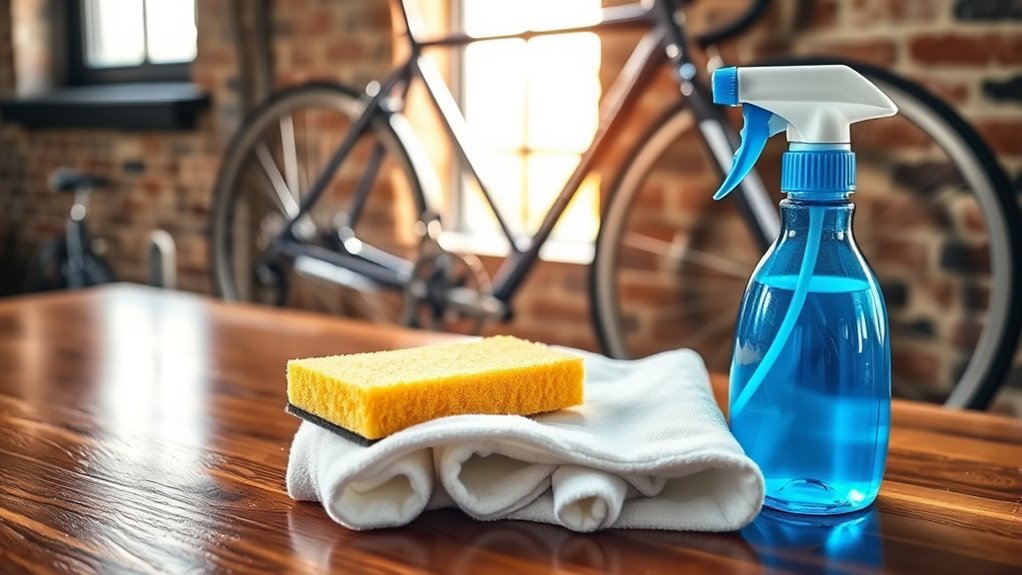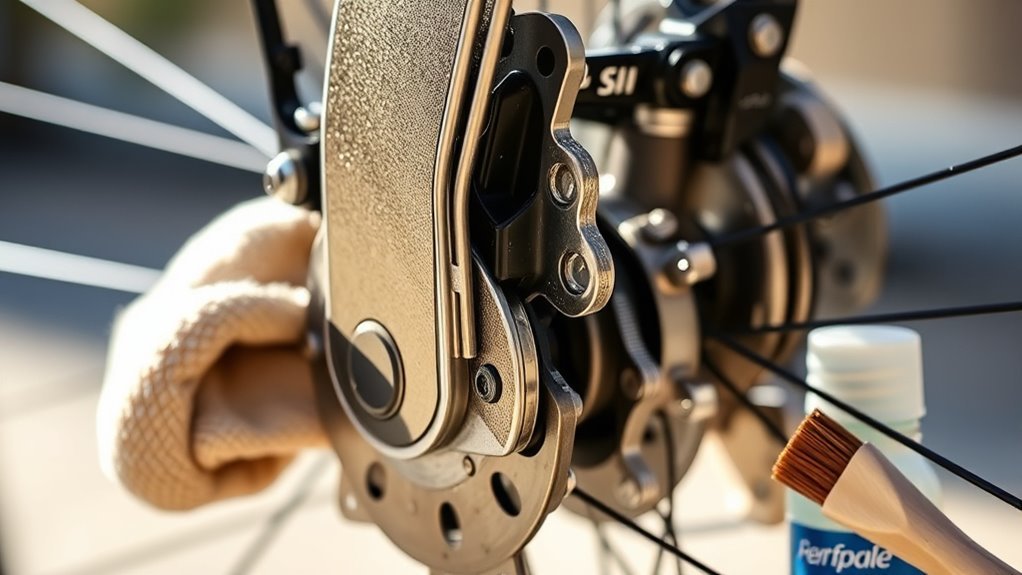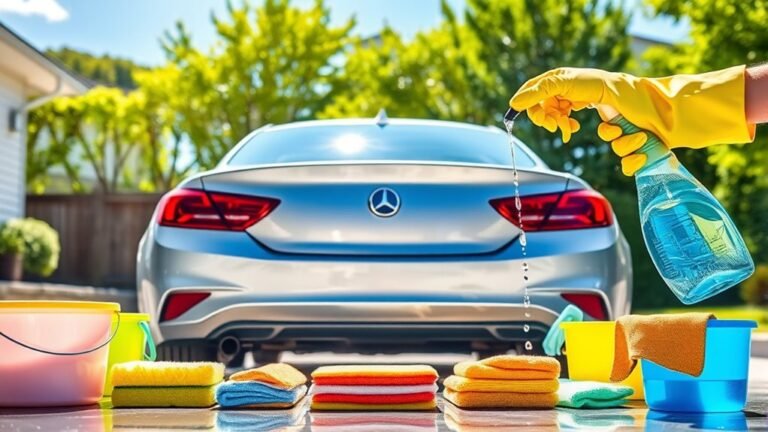Step-By-Step Guide to Cleaning Bike
To clean your bike effectively, start by gathering supplies like brushes, bike cleaner, and lubricant. Remove any accessories and rinse off loose dirt with water. Next, degrease and scrub the drivetrain and brakes, then clean the frame and wheels using a soft brush. Rinse and dry your bike thoroughly, then apply lubricant to the chain and pivot points. Finish by checking tire pressure, brake pads, and making final adjustments for smooth performance. Keep going to discover tips for deeper maintenance and care.
Gather Your Cleaning Supplies

Before you plunge into cleaning your bike, it’s important to gather all the supplies you’ll need. Freedom on two wheels comes with responsibility, and mastering proper cleaning techniques starts with having the right essential tools at hand. You’ll want a bucket, bike-specific cleaner, brushes of various sizes, a sponge, and a hose or spray bottle for rinsing. Don’t forget a chain lubricant and a rag for drying and detailing. These tools aren’t just about maintenance—they’re your ticket to keeping your ride smooth and ready for the open road. By prepping your cleaning kit, you guarantee each session is efficient, letting you spend less time scrubbing and more time exploring. With your supplies ready, you’re set to care for your bike and embrace the freedom it offers.
Prepare Your Bike for Cleaning
Before you start cleaning, make sure you’ve gathered all the necessary supplies. Take a close look at your bike to spot any damage that needs attention. Don’t forget to remove any accessories or gear to make the process easier and more thorough.
Gather Necessary Cleaning Supplies
You’ll need a few essential supplies to get your bike sparkling clean and running smoothly. The right cleaning techniques start with having the essential materials ready. These tools not only make the process easier but also help you maintain the freedom to ride without worry. Imagine the satisfaction of hitting the open road with a bike that looks and feels like new.
Here’s what you should gather:
- A soft brush or sponge to gently remove dirt without scratching
- Bike-specific degreaser to break down grime on the chain and gears
- Clean water and a bucket to rinse off residue and keep everything fresh
With these supplies, you’re set to restore your bike’s shine and performance, keeping your rides carefree and exhilarating.
Inspect Bike for Damage
Although cleaning your bike is important, taking a moment to inspect it for any damage can save you from bigger problems down the road. Start by checking the frame integrity—look for cracks, dents, or bends that could compromise your ride’s safety and freedom. Next, examine your tire condition; verify there are no punctures, excessive wear, or embedded debris that might cause flats. Don’t forget to press on the tires to confirm they hold air properly. Spotting these issues early lets you fix them before they turn into a roadside nightmare. A thorough pre-cleaning inspection keeps your bike reliable and ready for the open road, so you can enjoy every ride without unexpected setbacks.
Remove Accessories and Gear
Since cleaning is easier without extra parts in the way, start by removing all accessories and gear from your bike. Accessory removal lets you reach every nook and cranny, freeing your bike from hidden dirt and grime. Plus, it prevents damage to delicate parts during cleaning. Once removed, organize your gear for easy access next ride. Proper gear storage keeps your essentials safe and ready to roll, fueling your next adventure.
Think of accessory removal as shedding weight, a step toward pure freedom on two wheels. Before you get started, gather your accessories like:
- Lights and reflectors
- Water bottles and cages
- Saddle bags and mounts
This simple step clears the path for a thorough clean and keeps your gear ready for the open road.
Rinse Off Loose Dirt and Debris
Before you plunge into scrubbing, give your bike a thorough rinse to remove loose dirt and debris. This essential step in bike washing prevents grime from scratching your frame during cleaning. Use a gentle spray from a hose or a bucket of water to loosen mud and dust hiding in hard-to-reach spots. Focus on areas like the wheels, frame, and forks where dirt tends to accumulate. Rinsing off this surface dirt makes the dirt removal process smoother and protects your bike’s finish. Taking the time here means less elbow grease later, letting you enjoy the freedom of a clean, well-maintained ride without hassle. This simple rinse sets the stage for a deeper clean without damaging your bike’s delicate parts.
Clean the Drivetrain Components

Once you’ve rinsed off the loose dirt, it’s time to focus on cleaning the drivetrain components. Proper drivetrain maintenance is key to keeping your bike running smoothly and freeing you to explore without limits. Use effective cleaning techniques to remove grease, grime, and buildup from your chain, cassette, and chainrings.
Start by applying a degreaser to these parts, then scrub gently with a stiff brush. Rinse thoroughly and dry to prevent rust.
- Feel the thrill of a smoothly shifting bike.
- Enjoy the freedom of effortless pedaling.
- Extend your bike’s life with simple care.
Scrub the Frame and Wheels
When scrubbing the frame and wheels, picking the right brush is key to avoid scratches while reaching tight spots. You’ll also want to use an effective cleaning solution that cuts through dirt without damaging the bike’s finish. Let’s explore how to choose both for the best results.
Choosing the Right Brush
Although it might seem straightforward, choosing the right brush is essential for effectively scrubbing your bike’s frame and wheels without causing damage. You want a brush that balances toughness and gentleness, so your bike stays in top shape while you enjoy the open road.
Consider these key points when picking your brush:
- Brush materials: Opt for soft nylon bristles to protect paint and avoid scratches.
- Brush sizes: Use larger brushes for broad frame areas and smaller, stiff-bristled brushes for tight spaces like wheel spokes.
- Ergonomics: Choose a brush with a comfortable handle to make scrubbing feel less like a chore and more like a step toward freedom.
With the right brush, cleaning becomes part of your ride’s adventure, not a burden.
Effective Cleaning Solutions
Choosing the right brush sets you up for success, but the cleaning solution you use plays an equally important role in scrubbing your bike’s frame and wheels effectively. To keep your ride gleaming without harming the planet, opt for eco friendly cleaners or whip up your own homemade solutions using simple ingredients like vinegar, baking soda, and water. These options break down dirt and grime while being gentle on your bike’s finish and the environment. Avoid harsh chemicals that can strip protective coatings or damage rubber parts. Apply your chosen solution generously, then scrub with your brush to loosen stubborn dirt. Rinse thoroughly with clean water to reveal a fresh, clean bike ready for your next adventure, free and unburdened.
Clean the Brakes and Brake Pads

To keep your bike stopping smoothly, you’ll want to clean the brakes and brake pads regularly. Brake cleaning guarantees your freedom on the road, preventing unexpected slips and giving you control when you need it most. Start by removing dirt and grime with a dedicated brake cleaner or rubbing alcohol. Check your brake pads for wear; if they’re too thin or cracked, it’s time for pad replacement. Clean, responsive brakes mean safer rides and more confidence on every trail.
- Feel the power of precise stopping with every squeeze.
- Trust your bike to protect you on every adventure.
- Embrace the open road without hesitation.
Keeping your brakes in top shape lets you chase horizons without limits.
Rinse and Dry the Bike Thoroughly
Once you’ve scrubbed away the grime, you’ll want to rinse your bike thoroughly to remove all soap and dirt residue. Use a gentle stream of water—too much pressure can damage components or force water into bearings. Aim to wash away every trace of cleaner, leaving your bike fresh and ready for the next steps.
Next, focus on effective drying techniques to prevent rust and water spots. Use a clean microfiber cloth to wipe down the frame, wheels, and drivetrain. Pay close attention to hard-to-reach areas where water tends to collect. If possible, let your bike air dry in a shaded, breezy spot to guarantee complete water removal. Mastering this step frees you to ride with confidence, knowing your bike is clean and protected.
Lubricate the Chain and Moving Parts
Although your bike is clean and dry, the chain and moving parts still need proper lubrication to keep everything running smoothly. Chain maintenance isn’t just about preventing rust; it’s about preserving the freedom you feel when you ride. Using the right lubrication techniques guarantees your bike responds effortlessly, letting you conquer any road or trail.
Here’s how to nail it:
- Apply lubricant sparingly on the chain’s inner links to avoid attracting dirt.
- Focus on pivot points in derailleurs and brake levers for smooth control.
- Wipe off excess lubricant to prevent grime buildup that hinders performance.
Taking these steps empowers you to ride farther and freer, with every turn of the pedals feeling as liberating as the open road ahead.
Inspect and Make Final Adjustments
Before you hit the road, it’s essential to inspect your bike thoroughly and make any final adjustments. These safety checks guarantee your bike performance is at its best, giving you the freedom to ride confidently. Check tire pressure, brake responsiveness, and gear shifting smoothness. Tighten any loose bolts and make certain the seat and handlebars are secure.
| Component | What to Check | Adjustment Tip |
|---|---|---|
| Tires | Pressure & tread | Inflate to recommended PSI |
| Brakes | Pad wear & response | Align pads and test lever |
| Gears | Smooth shifting | Adjust cable tension |
| Bolts & screws | Tightness | Use proper torque settings |
| Seat & Handlebars | Stability | Tighten clamps securely |
A quick inspection keeps you safe and your bike performing freely.
Frequently Asked Questions
How Often Should I Clean My Bike for Optimal Performance?
You should adjust your cleaning frequency based on how often and where you ride. For best performance, cleaning your bike every 1-2 weeks gives you a solid performance boost, especially if you ride in wet or dusty conditions. Keeping your bike clean helps it run smoother and last longer, so you’re free to enjoy the open road without worrying about mechanical issues slowing you down.
What Are the Best Cleaning Products for Eco-Friendly Bike Care?
Did you know 70% of water pollution comes from everyday household products? When caring for your bike, you’ll want to choose biodegradable soaps and natural degreasers to keep things eco-friendly. These products break down quickly, so you’re not trapping the planet while you ride free. Using them means you can clean your bike thoroughly without harsh chemicals, letting you enjoy the open road and protect nature at the same time.
Can I Use a Pressure Washer to Clean My Bike?
You can use a pressure washer to clean your bike, but you’ve got to be careful. While pressure washer benefits include quick removal of dirt and grime, too much force can damage bearings and delicate parts. Instead, opt for gentle bike cleaning techniques, like low-pressure sprays or hand washing. This way, you keep your bike in top shape and enjoy the freedom of smooth rides without risking costly repairs.
How Do I Protect My Bike’s Paint During Cleaning?
Want your bike’s paint to shine like the open road calling? You’ve got to treat it right with proper paint protection during cleaning. Use gentle cleaning techniques—soft brushes and mild soap—to avoid scratches. Avoid harsh chemicals or high-pressure washers that can chip the paint. After washing, apply a quality bike-specific wax or polish; it acts like armor, preserving that fresh, free-spirited look every ride deserves.
What Maintenance Should Follow a Deep Bike Cleaning Session?
After a deep cleaning, you’ll want to give your bike some freedom to perform at its best. Start with chain lubrication to keep everything running smooth and prevent rust. Don’t skip brake adjustments either; clean brakes can lose their alignment, so tweak them for reliable stopping power. This simple maintenance guarantees your ride stays safe and smooth, letting you enjoy every adventure without a hitch.






